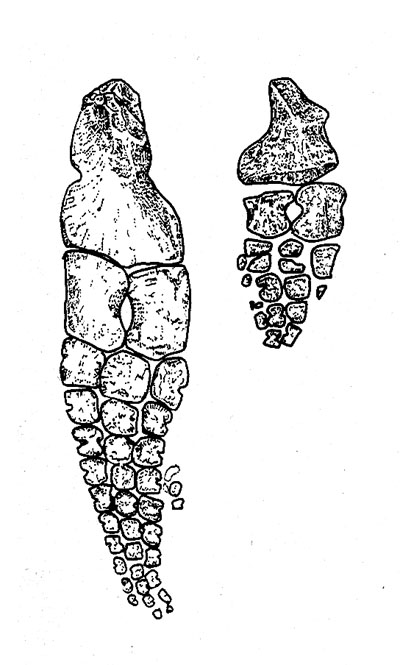
Species: californicus MERRIAM, 1902
Etymology: In reference to California, where the specimen was discovered.
Holotype: UCMP 8100
Locality: A few miles northeast of Winthrop, Bear Cove, Shasta County, California.
Horizon: Hosselkus Formation Formation.
Biostratigraphy: Trachyceras Zone.
Age: Carnian Stage, Lower Late Triassic Epoch, Late Triassic.
Material: Ribs, middle, posterior dorsal and anterior caudal vertebrae, the pelvic arch, both hind limbs and the right anterior limb.
Referred material:
LUCAS & GONZALEZ-LEON, 1995, LUCAS, 2002
Locality: Sierra del Alamo, Northwestern Sonora, Mexico.
Horizon: Antimonio Formation.
Biostratigraphy: Horizons, A, D and E, Dilleri zone.
Age: Upper Carnian Stage, Middle Late Triassic Epoch, Late Triassic.
Material:
ERNO-A1:Dorsal centra.
Note: Unit 3.ERNO-A3: Dorsal centra.
Note: Unit 27.ERNO-A4: 2 damaged centra.
Note: Unit 3.
_____________________________________________________________________________________
Species: zitteli (MERRIAM, 1903) MOTANI, 1999
Etymology: In honor of Alfred von Zittel.
= Leptocheirus zitteli MERRIAM, 1903
= Merriamia zitteli (MERRIAM, 1903) BOULENGER, 1904
Holotype: UCMP 8099
Locality: From a few miles northeast of Winthrop, Smith’s Cove, Shasta County, California.
Horizon: Hosselkus Formation Formation.
Biostratigraphy: Trachyceras Zone.
Age: Carnian Stage, Lower Late Triassic Epoch, Late Triassic.
Material: Lower half of a skull with a part of dentition, the complete pectoral girdle, both anterior limbs, and numerous fragmentary ribs, vertebrae and abdominal ribs.


Fore and hind fin.